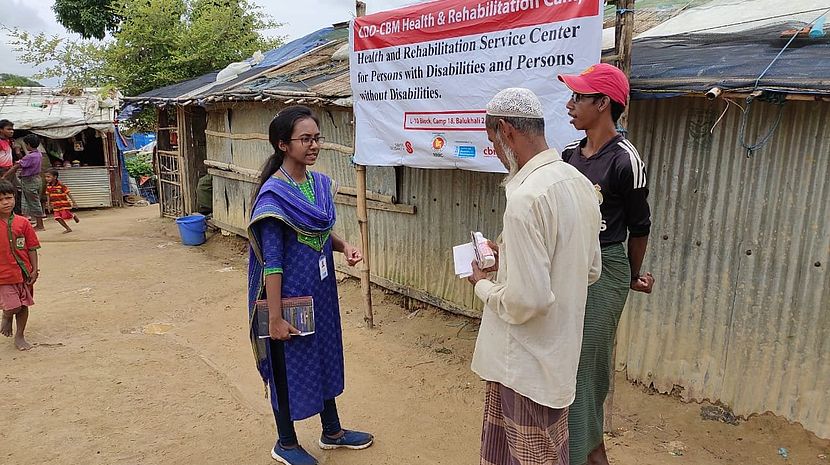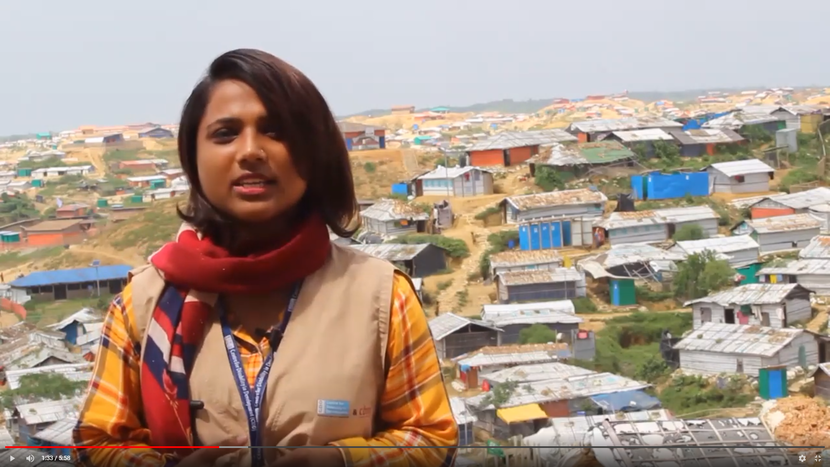15.08.2019 What's it like working as an inclusion coordinator?

©CBM
The following is from an 2019 interview with Tahmida Akter, an Inclusion Coordinator with CBM partner Centre for Disability in Development (CDD) responding to the Rohingya crisis in Cox's Bazaar, Bangladesh.
What is your current role with the Centre for Disability in Development (CDD)?
I started my journey with CDD as an occupational therapist, then I moved into the role of ‘Inclusion Officer,’ and now I am working as Inclusion Coordinator.
Here, I am managing/supervising an inclusion team, a team of three inclusion officers and one senior training officer. As well as this I am coordinating disability mainstreaming projects along with providing technical support in the different clusters (WASH and Protection), and Technical Working Groups.
I find this is a very dynamic role, where I deal with new challenges and opportunities regularly. Some days I go to the camp to visit field activities of partner organisations and provide on-site technical support, onsite capacity building training, etc. Other days, I work in Cox’s Bazar and attend different cluster meetings, providing technical support to the cluster for the better inclusion of older people and people with disabilities. Additionally, I am working with the Age and Disability Task Force (ADTF) and maximise communication with other humanitarian agencies so that they can reach our support for disability mainstreaming.
How did you come to work in the field of humanitarian response? What were you doing before this?
Before joining the CDD, I worked with the Centre for the Rehabilitation of the Paralysed (CRP) as a clinical occupational therapist for about four years. Although I am experienced working in different areas of Bangladesh, I was very keen to know more about community-focused service and the humanitarian context; and, fortunately, I got the opportunity from CDD.
How have your previous experiences helped you in your current role?
The previous job experience helped me a lot in my current role. Being an occupational therapist, I have learned to think holistically. I was dedicated to work on accessibility, reasonable accommodation, adaptation/ modification of home and office environment along with other responsibilities. I dealt and solved the real problem in participating daily activities by people with disabilities in their own context/house, and I am happy that I am getting the scope to utilise and build on my previous experience and knowledge here in disability mainstreaming and inclusion. Moreover, I am more than happy to support humanitarian sectors/clusters and different humanitarian agencies for disability mainstreaming.
What are the biggest challenges you face?
Humanitarian actors do wish to ensure inclusion of people with disabilities. However, there is lack of training or knowledge on how to do this. Besides, in this context there is a very limited number of organisations who are working on disability mainstreaming. So, it is difficult for us to provide all the support required by all of the agencies.
There are also few people with skills and experience in disability inclusion, and only a few organisations are hiring people in ‘inclusion’ positions—although this is changing.
This is often a gap between knowledge and practice, from the designing phase of a project to fully including people with disabilities.
What do you enjoy most of all? What inspires you?
I enjoy learning the context and barriers facing older people and people with disabilities, and then making contextual solutions. I also enjoy advocacy and networking with the clusters and humanitarian agencies to promote disability inclusion more widely.
I like to see the impact of our work. For example, from CDD-CBM, we—my colleague Emma and I—provided technical support to the sanitation Technical Working Group for accessible WASH (Water, Sanitation and Hygiene) design consideration, based on the humanitarian context for developing inclusive WASH guidelines. Once these guidelines were published, different humanitarian agencies will use them and people with disabilities will benefit.
What are your hopes and dreams for the future?
I want to contribute more on disability mainstreaming and inclusion in the humanitarian field.
I hope and believe that in the near future, government (of all levels) and humanitarian agencies will be more aware and continue to show more willingness to increase disability mainstreaming. I also hope that people with disabilities will get more opportunities to strengthen their representation in disability mainstreaming and inclusion, and will; therefore, be more involved in global development.
